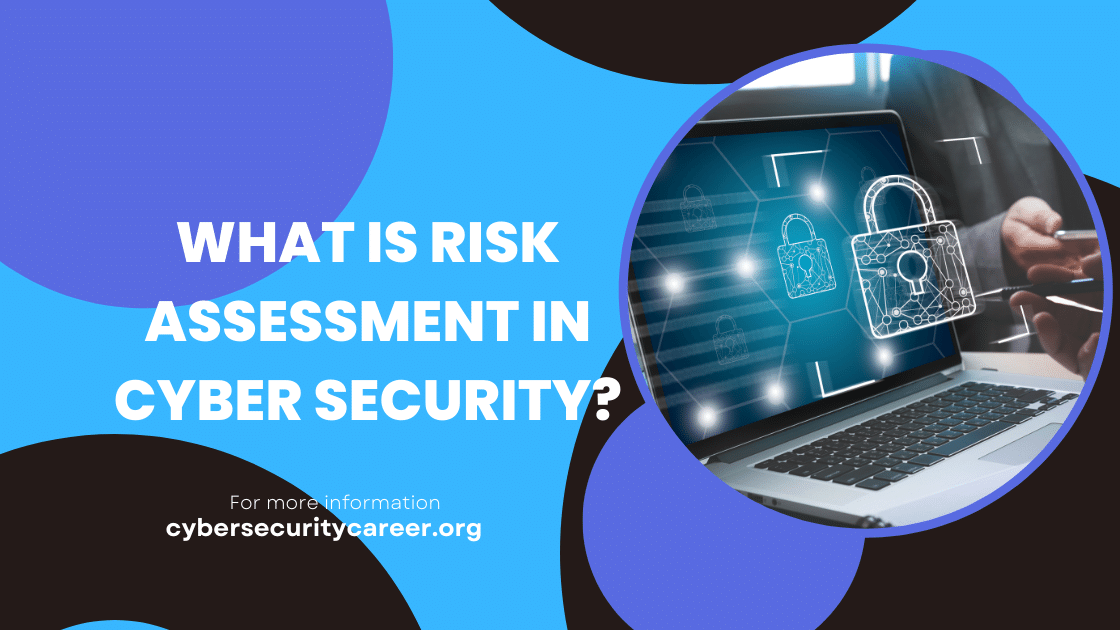Organizations may better identify, manage, and mitigate all types of cyber Risk using cybersecurity risk assessments. It is an essential part of data protection and risk management strategies.
Whether you like it or not, if you work in information security, you are in the risk management industry. Risk assessments are nothing new. The digital risk threat landscape grows as businesses rely more on information technology and information systems to do business, exposing ecosystems to new, serious vulnerabilities.
The National Institute of Standards and Technology (NIST) has created a cybersecurity framework to serve as a foundation for risk assessment procedures.
What is A cyber risk assessment?
According to NIST, cyber risk assessments are used to identify, evaluate, and prioritize Risk to organizational operations, organizational assets, people, other organizations, and the nation as a whole from information systems’ usage and operation.
A cyber risk assessment’s main objective is to inform stakeholders and promote appropriate actions to hazards that have been identified. They also offer an executive summary to assist executives and directors in making wise security decisions.
The information security risk assessment process addresses the following inquiries:
- What are the most crucial information technology resources for our company?
- Which data breach, caused by malware, a cyberattack, or human error, would significantly impact our business? Consider client data.
- Can every potential threat source be found?
- What is the possible severity of each danger that has been identified?
- What are the weaknesses on the inside and outside?
- What would happen if those flaws were used against us?
- What is the chance of being exploited?
- What security lapses, cyber threats, or attacks could jeopardize the company’s capacity to conduct business?
- What level of Risk is acceptable to my organization?
You can decide what to protect if you can respond to those queries. This implies that you can create data security plans and IT security controls for risk mitigation. However, before you can accomplish that, you must respond to the following queries:
- What Risk am I minimizing?
- Is this the security risk with the highest priority?
- Am I minimizing the Risk most economically?
This will enable you to better comprehend your information risk management approach in safeguarding business demands and assist you in grasping the information value of the data you are attempting to protect.
How to Conduct a Cyber Risk Analysis?
Following a high-level overview, the following sections will go into greater detail about each phase. Before beginning risk assessment and mitigation, you must be aware of the data you have, the infrastructure you use, and the importance of the data you are attempting to safeguard.
Starting with an examination of your data to provide answers to the following inquiries
- How do we gather data?
- How and where are these data being stored?
- How can we safeguard the data and record it?
- How long are the data stored?
- Who has access to the data both internally and externally?
Is the location where the data is being stored appropriately secured? Check your S3 permissions before someone else does, as poorly set up S3 buckets are a common source of breaches.
- The next step is to specify the assessment’s parameters. Here are some excellent starter inquiries to get you going:
- Regular IT security evaluations are crucial.
- Regularly performing a thorough IT security audit helps firms build a strong base for assuring commercial success.
It specifically gives them the ability to:
- Find and fix any IT security holes
- To reduce risks, pick the right methods and controls.
- Protecting the item with the highest value and greatest Risk should come first.
- Remove pointless or outdated control measures
- Consider prospective security partners
- Establish, uphold, and demonstrate compliance with the rules
- Accurately predict future requirements
What is the goal of the evaluation?
- Are there any priorities or limitations I should be aware of that might impact the evaluation?
- Who in the company must I have access to obtain all the information I require?
- What risk model is applied by the company while analyzing risks?
The answers to many of these questions are obvious. What you need to know is what you’ll be assessing, who has the knowledge to do an accurate assessment, and are there any budgetary or regulatory obligations you need to be aware of.
Now that you have a risk assessment form let’s look at the procedures that must be taken to complete a full cyber risk assessment.
What issues are resolved by a security risk assessment?
A thorough security evaluation enables a company to:
- Identify the organization’s resources, such as its network, servers, apps, data centres, tools, etc.
- For each asset, create risk profiles.
- Recognize the types of data generated, transported, and stored by these assets.
- Determine how vital an asset is to a company’s operations. Included are the general effects on revenue, reputation, and the likelihood of a company being exploited.
- Prioritize assets for examination based on their risk ranking.
- Based on the evaluation findings, implement mitigation controls for each asset.
It’s critical to realize that a security risk assessment is a continuous process. Instead, it should be a continual action that happens at least twice every two years. An organization can get a timely and accurate snapshot of the threats and risks to which it is exposed through continuous assessment.
- At Synopsys, we advise annual evaluations of vital assets with a higher risk and impact. Numerous useful pieces of information are generated and gathered during the assessment process. Several instances include:
- Assembling a portfolio of all the current software, utilities, and tools.
- Creating documentation for security standards, guidelines, and practices.
- assembling a database of system architectures, network diagrams, data that systems store or communicate, and connections with outside suppliers or services
- Creating a list of physical assets (e.g., hardware, network, communication components and peripherals).
- Keeping records of operating system information (e.g., PC and server operating systems).
Detailed facts about:
- Data archival systems (e.g., database management systems, files, etc.).
- Present-day security measures (e.g., authentication systems, access control systems, antivirus, spam controls, network monitoring, firewalls, intrusion detection, and prevention systems).
- Regulating authorities’ compliance with the current minimum operational and security standards.
- Assets, dangers, and weaknesses (including their impacts and likelihood).
- Application, policy, network system, and other previous technical and procedural reviews.
- Mapping of risk-reduction measures for every asset’s assessed Risk.
How is a cybersecurity evaluation carried out?
Given their business or the regional regulations that apply to them, an effective cybersecurity assessment may differ from one firm to the next. Still, its fundamental components always remain the same. When doing a cybersecurity assessment, remember to follow these important rules:
Assess the assessment’s scope.
Determine the full scope of the cybersecurity evaluation by listing all the assets that will be examined. Instead of doing everything at once, it could be advantageous to start by focusing only on one kind of asset at a time. Determine any other assets, gadgets, or data that the asset type you’ve chosen touches. By doing this, you can be sure you’re obtaining a complete picture of your network.
Establish the value of each asset.
It would help if you ascertained the value of each asset after deciding which ones will be included in the assessment. It’s crucial to remember that an asset’s genuine value could go beyond its purchase price. Your team must consider qualitative hazards connected to each asset and intangible considerations when doing the asset assessment.
Recognize cybersecurity threats
Finding cybersecurity risks is the next phase in a cybersecurity assessment, allowing you to estimate the possibility of various loss scenarios and use that information to make future decisions. Think about the potential uses for the asset, the likelihood of use, and the overall effect use could have on your business. This is a crucial step in ensuring that your company successfully adheres to any cybersecurity compliance standards demanded by your sector.
Examine the asset’s value at the expense of prevention.
When an asset’s value has been established, it must be weighed against the expense of protecting it. Determine different loss scenarios to see if it would be worthwhile to pursue an alternative control or preventive approach that makes more financial sense if the expense of preventing such accidents exceeds the asset’s value.
Install and regularly check security measures
The next stage is to build security measures that can continuously monitor your organization’s cybersecurity once you have discovered and assessed the crucial assets and vulnerabilities within your network. This will guarantee that the controls are continuously safeguarding sensitive information and meeting organizational needs.
How is a cyber security risk assessment carried out?
The information assets potentially impacted by a cyber assault are identified through a cyber security risk assessment (such as hardware, systems, laptops, customer data and intellectual property). The risks that might have an impact on such assets are then identified.
Typically, a risk calculation and appraisal are done, and controls are chosen to address the risks discovered.
It is crucial to continuously monitor and assess the risk environment to identify any changes in the organization’s context and keep track of the entire risk management process.
What is a risk assessment for cyber security?
In a typical risk assessment, the different information assets that could be impacted by a cyber attack are first identified (such as hardware, systems, laptops, customer data, intellectual property, etc.). Then the different threats that could impact those assets are identified. Typically, a risk calculation and evaluation are done before choosing the controls required to address the risks that have been identified. It is crucial to monitor and assess the risk environment to identify any changes in the organization’s context and keep track of the entire risk management process.
Cyber threats and ISO 27001
A best practice is defined by the international standard ISO/IEC 27001:2013 (ISO 27001). Information security risk management uses an ISMS (information security management system) that considers people, procedures, and technology.
The requirements for the information security risk assessment procedure are outlined in Clause 6.1.2 of the Standard. Businesses must:
- specified information security risk criteria should be established and maintained;
- Make ensuring that repeated risk analyses “yield consistent, reliable, and similar results”;
- Find “risks related with the loss of confidentiality, integrity, and availability for information within the scope of the information security management system” and find out who is responsible for those risks;
- Analyze and assess information security threats in light of the previously set standards.
- Organizations must “retain documented information on the information security risk assessment process” to prove that they comply with these rules.
The information security risk treatment method requires them to complete several tasks and produce pertinent documents.
Cyber risk assessment service for IT Governance
Our group of knowledgeable cyber security consultants will offer business-driven advice on the complete procedure of evaluating information risk. They will provide assistance, direction, and counsel in the following areas:
- Determining which assets need to be protected.
- Finding the necessary threats and weaknesses.
- Locating vulnerable points that can be exploited.
- Determining the danger level posed by threat agents.
- Figuring out the effects of risks being realized on the business.
- Creating a security risk evaluation.
- Recommending a level or threshold of risk acceptability.
- Advising on the best way to establish controls.
A thorough enterprise security risk assessment should be carried out at least once a year or whenever there are substantial changes to the company, the IT estate, or the legal environment to explore the risks connected with the organization’s information systems. An ongoing effort should be a cyber risk assessment. An enterprise security risk assessment can provide only a momentary snapshot of the dangers posed by the information systems.
For whom is the service of cyber risk assessment intended?
Small, medium-sized, and large businesses can benefit from risk assessment consulting services if their IT architecture combines intricate legacy systems with more modern operating systems whose compatibility isn’t always perfect.
It is especially helpful to public-sector organizations that offer services through various channels to various user groups since the exchange of personal data across various platforms necessitates increased monitoring and protective measures.
Useful risk assessment tools
When handling complex risk assessments, the risk assessment software application vsRisk has been shown to save enormous amounts of time, effort, and money. The risk assessment process is streamlined by vsRisk, fully compliant with ISO 27001, to produce uniform and repeatable cyber security risk assessments every time.
Three new features have been added to the most recent version of vs Risk: control set synchronization, custom acceptance criteria, and a risk assessment wizard. The asset database can now be exported and imported into a register or asset management system.
Learn more about vsRisk
Cyberhealth Assessment
This three-day, fixed-price Cyber Health Check includes testing, vulnerability assessments, consulting, and audit to determine your cyber risk exposure. Our four-step process will help you identify your actual cyber threats, evaluate how well you’ve handled them, determine how many risks you face, and develop a prioritized action plan for managing those risks in line with your company’s goals.
The purpose of IT governance
IT Governance delivers a plethora of expertise in risk management and cyber security. We have provided thorough risk assessments for over ten years as part of our information security work with hundreds of private and public organizations across various industries. Every one of our consultants is a skilled professional.
FAQ – A risk assessment is what?
A cyber security risk assessment involves locating and evaluating information assets, threats, vulnerabilities, and incident impact on information security strategy.
What comes first in the process of risk assessment?
Identifying and evaluating the information assets throughout your firm are the initial steps in undertaking a risk assessment. Some of these are servers, client data, customer information, and trade secrets.
What constitutes the process’s last stage in risk assessment?
Documenting the findings as the process’s last phase can help decision-makers make well-informed judgments about budgets, policies, and procedures. Each danger should be described in the risk assessment report, along with any associated costs and weaknesses. Additionally, it ought to offer suggestions for reducing Risk.
A threat/vulnerability pair is what?
A threat/vulnerability pair occurs when one threat takes advantage of another threat’s weakness, for as, when a hacker (threat) uses an unpatched system (vulnerability). Not every attack can exploit a specific vulnerability. For instance, the Risk of flooding pairs with a lower-level server room’s vulnerability, but not with unpatched systems.
A threat action is what?
A threat/vulnerability pair results in a threat action, the outcome of the recognized threat exploiting the matched vulnerability. For instance, if the vulnerability is a lack of system patching and the danger is hacking, the threat actor may be a hacker taking advantage of the unpatched system to gain unauthorized access.
How is risk assessment carried out?
You must first identify the components of the risk equation and then utilize your understanding of those components to calculate Risk to conduct a cybersecurity risk assessment. That implies:
- calculating the value of the information assets in your company
- knowing the threats that each asset might face
- providing information on the weaknesses that could allow those threats to cause damage to the asset
- evaluating the costs involved
After gathering this information, the following step is to develop a cybersecurity risk management plan that outlines the risks and mitigation techniques.
When ought risk assessment be done?
The process of assessing risks ought to be ongoing. As your IT assets change and new threats and vulnerabilities materialize, you should routinely examine your risk mitigation approach. Being transparent is essential for success. All parties involved in the data security process should be able to access information and contribute to the assessment.
What should be covered in risk analysis?
A study of cyber security risks should include:
- evaluating the importance of information to the organization
- a determination of dangers and weaknesses
- An analysis of the effects of leveraged threats
- Conclusions regarding hazards and methods of risk mitigation
- Assessment procedure documentation
Who should conduct the risk analysis?
If your company is large enough to have a dedicated IT staff, appoint them to fully comprehend your data infrastructure and collaborate with team members who know how information moves throughout your company. You might need to hire a specialist risk assessment company if your company is a small business without an IT department.










Leave a Reply